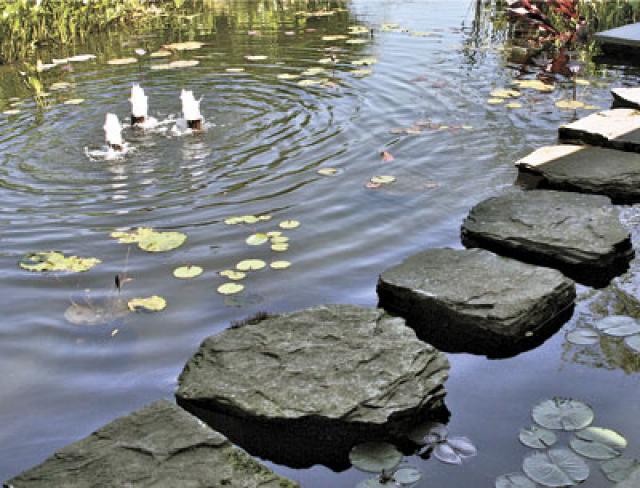Want a Water View? Build a Pond

For the garden that has everything, or so you thought, you can always give it a pond. Not everyone has a water view even though the East End is surrounded by water, but it is possible to create your own by building a pond. And many do. There’s something romantic about a pond: the lily pads, the scurry of fish, the croaking of frogs. So-called water features, which now ornament many a South Fork estate, come in many shapes and sizes. You can start with “fountainscapes” (fancy fountains to those not in the know), graduate to “pondless waterfalls,” which are cascades of water spilling over rocks and recirculating ad infinitum, and finish up with full faux ponds. Though most ponds are simply for aesthetic effect, some — basically Gunite pools bordered with rocks — are actually swimmable, while others are essentially hot tubs, manmade versions of hot springs or rural swimming holes. There’s been a noticeable increase in pond building at Pond Masters in Hampton Bays over last few years, according to the proprietor, John Malinowski. “What’s better at the end of a stressful day than to sit on a rock, dip your feet in the water, and feed the fish?” Ed Drohan, the owner of Sag Harbor’s Alter Ecosystems Ponds and Waterfalls, asked rhetorically the other day. And perhaps to ogle your very own waterfall as rivulets gush and gurgle from a ledge. “It’s like a living water garden,” Mr. Malinowski said. “A pond brings a lot more life to your backyard: birds, frogs, turtles. They just show up.” On maintenance calls to clean a pond he installed years ago on Middle Lane in East Hampton, Richard Cohen, a partner in Amagansett’s Rockwater Construction, has found cigar butts at its edges, testimony that the man of the house, a financier, winds down from the Wall Street hustle by spending long hours there. For the dozens of ponds he’s installed, from one with a serpentine shape at Shaare Pardes Oak Grove Cemetery in Springs, to one that fills an acre in East Hampton Village, Mr. Cohen, whose company has built ponds for more than 30 years, focuses on a naturalistic look. “Look at the lichen on that rock,” he said, admiring one of his ponds where Mother Nature had augmented his work. “It looks ancient.” A pond builder’s job starts with shaping a watery work of art, digging it, plumbing it, and then placing boulders — often tons of them — in carefully designed clusters. Mr. Cohen and his partner, Jim Kutz, do all the Rockwater work by hand, except for roughing out the pond itself. They cherry pick the rocks they use, mostly at farms in Pennsylvania, then have them hauled out of the fields by horses. For the many swimmable ponds he builds, Mr. Drohan focuses on making them people-friendly. “You need a proper balance of fish and plants,” he said. Asked if his clients swim with the fishes, he said, “Absolutely.” The shallowest ponds measure in at 3 feet, while the deepest are 15. They have to remain deep enough so that hibernating fish don’t freeze. “If you take a link out of the chain in your ecosystem the cycle won’t correct itself,” said Mr Drohan, who has installed more than 400 ponds in his career and has a background in aquatic biology. The result could be algae, cloudy water, or an infiltration of tannins that can turn the water the color of strong Earl Grey. He uses only organic ingredients to keep the water clean. Barley, for example, contains an enzyme that attacks algae. An ionization system that releases minute bits of copper can be put in, which also reduces algae. Another product coagulates particulates suspended in the water that then drop to the bottom where helpful bacteria chow down on them. Filters are also key. For a big swim pond, such as the one Mr. Drohan put in at Groundworks @ Hren’s in East Hampton, two filters pump 18,000 gallons of water over twin falls more than 20 times a day. That’s a lot of water. The equipment is hidden by rock formations and plants. “People don’t realize how many plants accept being wet constantly,” he said. His aquatic plant repertoire includes iris, cattails, rushes, sedges, hibiscus, and marshmallow, all rooted in gravel. Part of the reason for the trend toward artificial ponds is the improvement of materials such as pumps and liners, which make them successful. The old plastic liners didn’t last, said Mr. Malinowski of Pond Masters. Rubber linings made by Firestone and other companies now last 30 years, he said. The other reason that people are building ponds, of course, is that they can.
